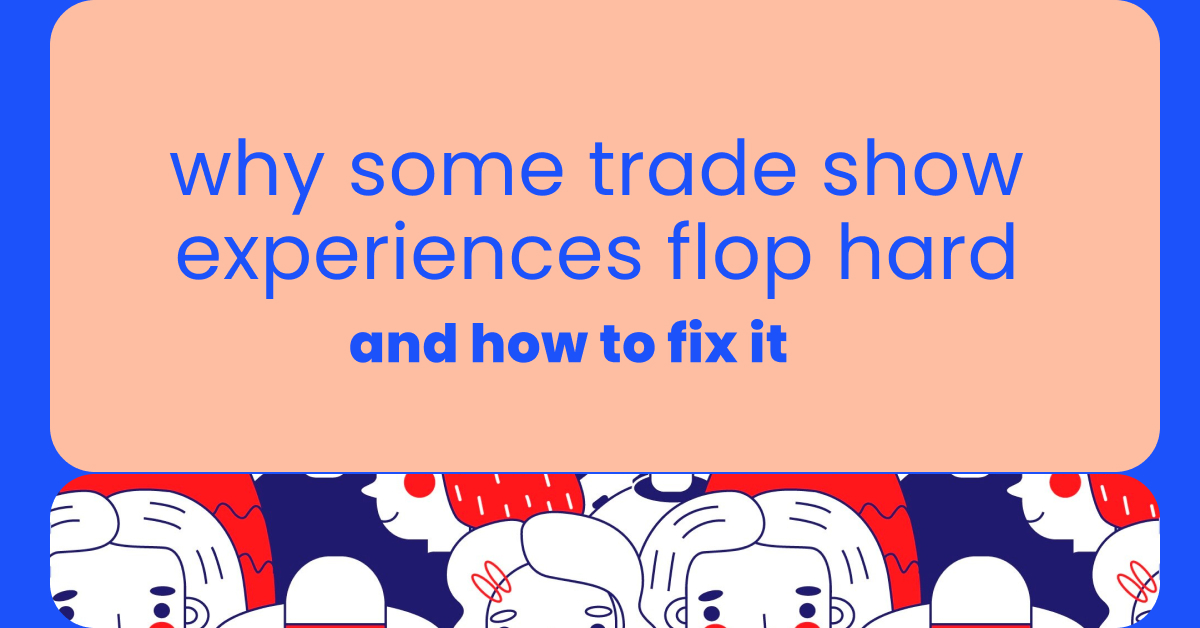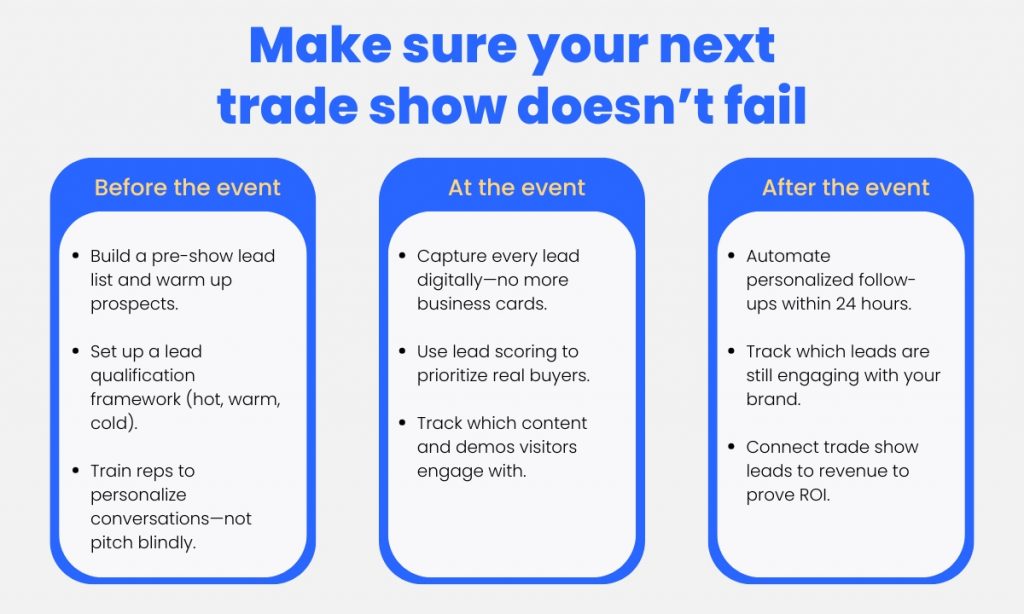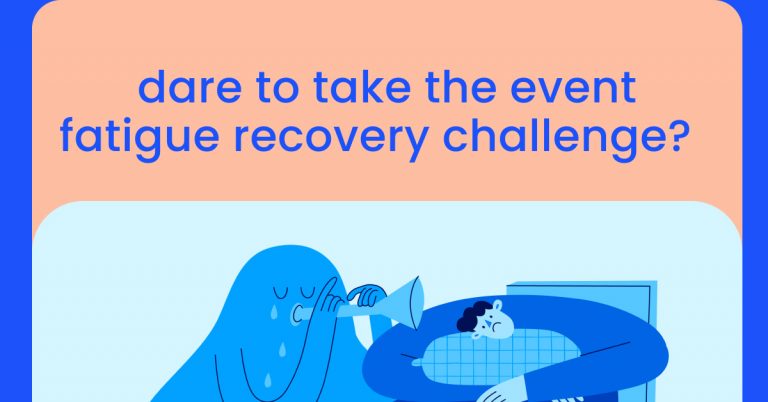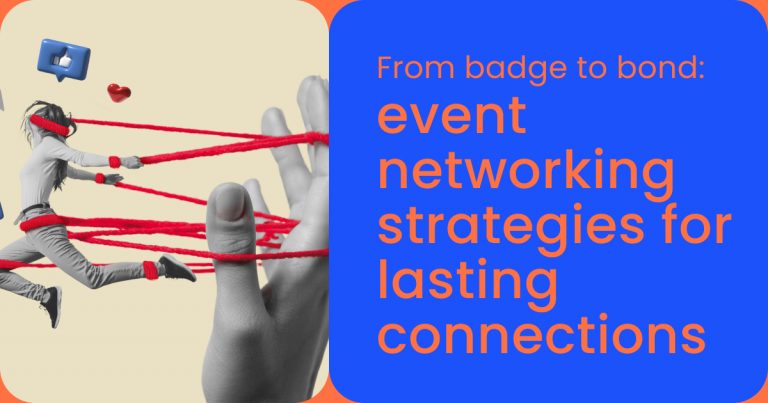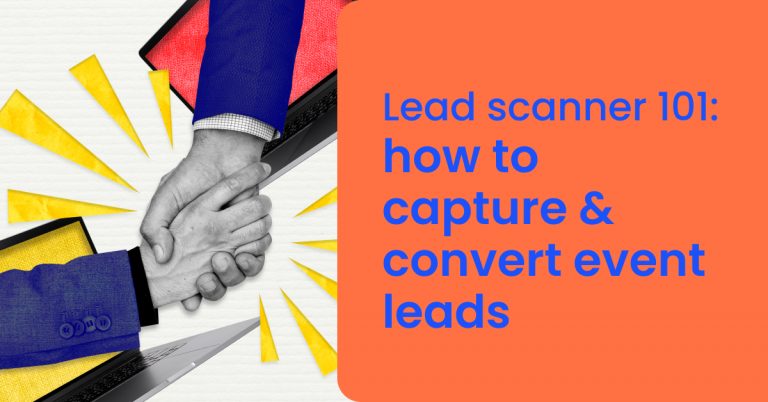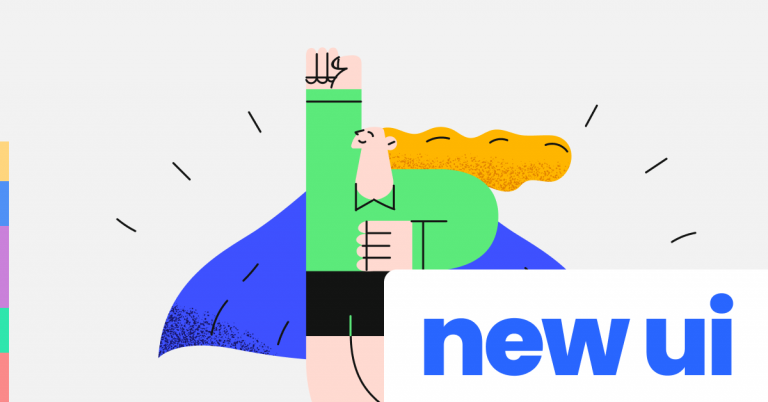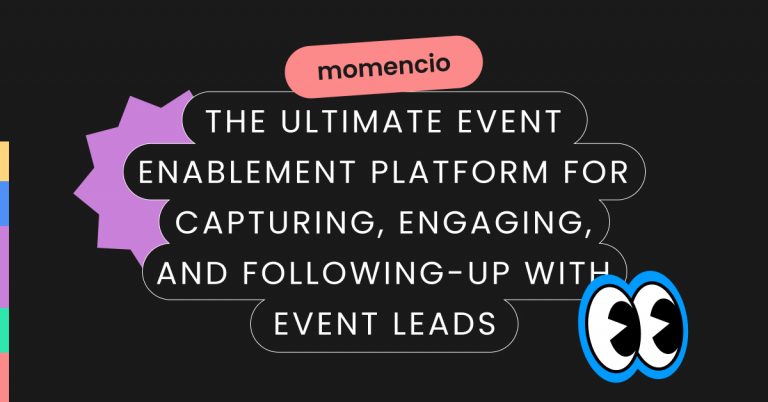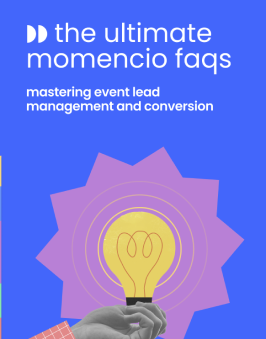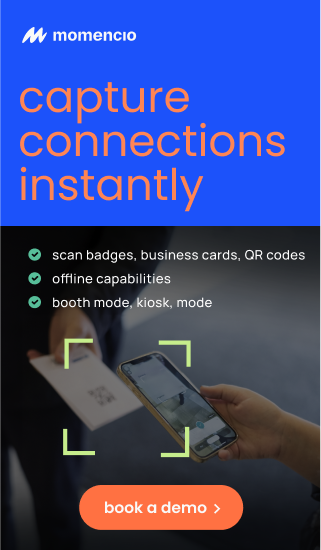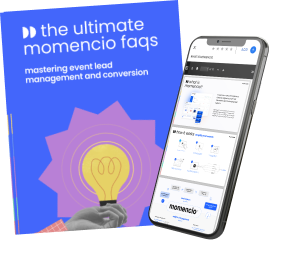Of late, trade show experiences have become a mystery. Businesses are spending an average of $10,000 to $100,000 per event on booth rentals, event tech, marketing, travel, and staffing. Yet, 70% of exhibitors fail to follow up with their leads after the event, leaving money on the table. Let us understand why that is and how your business can create trade show experiences worth remembering for your attendees.
You talked to a hundred people, but got zero real leads
You walk away from the trade show feeling great. Your booth was packed. Your team was busy from start to finish. But when you sit down to review the leads, reality hits: most of them aren’t actually buyers.
Now, you’re stuck with a bloated lead list full of people who:
- Were just grabbing swag and bouncing
- Gave you their contact info to be polite, not because they’re interested
- Had zero budget, zero authority, and zero intent to buy
This is where most exhibitors fail—they confuse conversations with conversions. Just because people stopped by your booth doesn’t mean they’re actual prospects. If you don’t filter the noise, you’ll spend weeks chasing dead leads while real buyers slip away.
Why this happens
- No lead qualification – Your team is talking to everyone the same way instead of figuring out who’s worth real attention.
- Relying on business cards and badge scans – If you’re still collecting business cards or scanning badges without lead scoring, you’re setting yourself up for post-show chaos.
- No real-time engagement tracking – You have no idea who actually cares about your product because you’re not tracking intent in the moment.
When you treat every lead equally, you end up wasting time on people who were never going to buy in the first place. And that’s why your sales team will hate you after the event—because they now have a messy, unqualified lead list to sift through.
How to fix it before the next show
Step 1: Qualify leads on the spot
Don’t let your reps have the same conversation with everyone. Instead, train them to qualify prospects in real-time using questions like:
- Are you currently looking for a solution like this, or just exploring?
- Do you handle purchasing decisions, or would someone else be involved?
- What’s the biggest challenge you’re trying to solve right now?
These simple questions separate the serious buyers from the casual attendees.
Step 2: Use lead scoring in real time
Not all leads deserve equal follow-up. With AI-powered lead scoring, your team can rank leads as hot, warm, or cold while they’re still at the booth. That way, you’ll know who needs an immediate sales follow-up vs. who should go into long-term nurturing.
Step 3: Trigger instant follow-ups
The faster you follow up, the more likely a lead is to convert. Instead of waiting days to send an email, automate follow-ups within minutes of the interaction. A simple “Hey [Name], great chatting today! Here’s a quick recap of our conversation and next steps” email keeps your brand fresh in their mind.
Step 4: Ditch business cards forever
Manually entering business cards into a CRM is a waste of time (and let’s be honest, most of them end up in a pile on someone’s desk anyway). Instead, use digital lead capture tools that sync directly to your CRM—so every contact is automatically stored, categorized, and ready for follow-up.
How momencio makes this simple
- AI-driven lead scoring – Know who’s ready to buy vs. who’s just browsing
- Instant post-meeting follow-ups – No delays, no forgotten leads
- CRM integration – Every contact automatically stored and categorized
No more wasted time. No more chasing the wrong leads. Just high-quality, sales-ready prospects straight from the trade show floor.
Your competitors owned the conversation—you were just “another booth”
You put in the effort. The booth design was on point. Your team was prepped. But by the end of the event, something felt off.
Your competitors had visitors lining up to talk to them. Attendees walked out of their booths still buzzing about their brand. Meanwhile, your team had plenty of conversations—but when you followed up, prospects barely remembered who you were.
You weren’t just competing for attention at the show. You were competing to be the company they remember after it’s over. And if your booth was just another stop on their long list of vendor visits, you lost.
Why this happens
- Your pitch was generic – Your reps said the same thing to everyone instead of making conversations personal and relevant.
- You didn’t give visitors a reason to stay – Competitors had something engaging—whether it was a hands-on demo, an exclusive experience, or a reason for people to return.
- You focused too much on talking, not enough on listening – You wanted to impress visitors with your product, but the best sales conversations start by understanding what the prospect actually needs.
- Your team lacked real-time insights – If your reps weren’t tracking what materials visitors engaged with, you missed the chance to tailor the follow-up conversation later.
Trade show attendees talk to dozens of vendors in a day. If you don’t make an impact in the moment, you’ll just be another forgettable interaction.
How to fix it before the next show
Step 1: Personalize every conversation
Instead of launching straight into a rehearsed pitch, start by asking questions:
- What brought you to the event today?
- What solutions are you currently using, and what’s missing?
- What’s the biggest challenge you’re facing in [industry-specific pain point]?
This does two things:
- It makes the prospect feel heard.
- It gives you the information needed to tailor your pitch to what actually matters to them.
Step 2: Use digital engagement tools to personalize in real time
A great trade show conversation isn’t just about what’s said—it’s about what’s shown. Instead of handing out generic brochures, use a digital content-sharing tool that lets your reps pull up relevant case studies, product demos, or ROI calculators based on the visitor’s specific needs.
This instantly makes the experience feel personalized and valuable—not just another sales pitch.
Step 3: Create an interactive experience that makes visitors want to stay
Competitors aren’t just selling their product—they’re creating an experience that attendees remember.
Instead of just standing at your booth waiting for people to stop by, think about:
- Hosting mini live demos that show the product in action
- Running a real-time industry challenge or quiz where attendees get insights tailored to their needs
- Using interactive lead capture tech where visitors engage with a self-serve experience and submit their own preferences
Step 4: Track visitor engagement and use it for better follow-ups
Most exhibitors follow up with the same email template for every lead. That’s why most follow-ups go ignored.
Instead, track which materials each visitor engaged with, and send a follow-up tailored to their interest. Example:
- If they watched a specific product demo, send them a deeper dive video or case study.
- If they asked about a particular feature, follow up with a custom proposal showing exactly how it fits their business.
- If they interacted with multiple reps, combine insights from those interactions so your follow-up feels coordinated, not disconnected.
How momencio makes this simple
- Smart content recommendations – Reps can instantly pull up the right materials based on the conversation.
- Real-time engagement tracking – Know exactly what each visitor interacted with so follow-ups feel personal, not generic.
- Seamless lead capture & CRM sync – Every conversation is logged automatically, making it easy to follow up with context.
If you’re not tracking visitor interest as it happens, you’re relying on memory—and that’s why follow-ups feel weak.
You waited until after the event to follow up—now it’s too late
The trade show ends. Your team is exhausted but feeling good. The booth was busy, conversations were solid, and you’ve got a list of leads ready to go.
A few days pass. Then a week.
When your sales team finally starts reaching out, most emails go unanswered. The few prospects who do respond barely remember who you are. Some already signed contracts with competitors.
This isn’t just frustrating—it’s a massive waste of time and money. If your follow-up isn’t immediate and relevant, you might as well not bother.
Why this happens
- Your team assumes “we’ll follow up next week” is good enough – It’s not. According to industry research, contacting leads within 24 hours increases conversion rates significantly. If you wait longer, interest drops fast.
- Your follow-ups are generic – “Hey [Name], it was great meeting you at [Event]. Let’s connect!” isn’t compelling. Prospects get dozens of emails like this post-event, and yours gets buried.
- You have no real context on the conversation – A lead that showed high intent at your booth should get a completely different follow-up than someone who just stopped by for swag. If you don’t differentiate, your outreach falls flat.
- You’re relying on manual follow-ups – If your sales team has to sort through spreadsheets, dig through notes, and manually craft outreach, it won’t happen fast enough.
Every exhibitor knows follow-up is important. The problem isn’t knowing—it’s execution.
How to fix it before the next show
Step 1: automate follow-ups in real time
Your best chance to convert a trade show lead is while they still remember you.
Set up an automated system that:
- Sends a personalized email within minutes of your booth interaction
- Includes a recap of the conversation and any materials they showed interest in
- Gives them an easy next step—schedule a call, get a demo, or explore more content
This isn’t just about speed. It’s about making your follow-up feel natural and useful, rather than another generic post-event email.
Step 2: segment leads for better messaging
Not every lead should get the same follow-up. Break them into three categories:
- Hot leads (high intent, decision-makers) → Immediate, personalized outreach with a call-to-action
- Warm leads (interested but need nurturing) → Targeted resources, case studies, or an invite to a post-event webinar
- Cold leads (not a priority now) → A long-term nurture sequence that keeps your brand top of mind
This ensures high-value leads get the attention they deserve, while lower-priority contacts stay engaged without draining sales resources.
Step 3: track engagement after the event
Your job isn’t done after the first email. If a lead opens your email, clicks a link, or watches a video, your sales team should know in real time.
- Who actually engaged with your follow-up? Those leads should be prioritized for calls.
- Who ignored your email? Try a different approach—maybe a LinkedIn message or a direct mail touchpoint.
- Who clicked but didn’t reply? They’re interested but not ready—perfect for a targeted nurture campaign.
How momencio makes this simple
- Automated post-show sequences – No more delayed follow-ups. Emails go out instantly, keeping leads warm.
- Engagement tracking – Know who’s opening, clicking, and interacting, so sales focuses on the right leads.
- One-click meeting recaps – Send detailed follow-ups based on real conversations, not generic templates.
If you’re waiting days or weeks to follow up, you’re already too late. The exhibitors who win are the ones who act while the lead is still thinking about them.
You have no idea what worked and what didn’t
Your boss asks, “How did the trade show go?”
You hesitate. The booth was busy. Conversations felt productive. But when it comes to hard numbers, you have nothing concrete.
- How many leads were actually qualified? No clear answer.
- Which marketing channels drove the best traffic? No data.
- What percentage of your leads converted into sales? No idea.
So now, you’re stuck justifying the event budget without solid proof that it was worth it. And when next year rolls around, you won’t know what to double down on—or what to stop wasting time on.
Why this happens
- You aren’t tracking lead sources – If you don’t know whether your best leads came from pre-show outreach, booth traffic, or networking events, you’re guessing instead of optimizing.
- You have no way to measure engagement – Did attendees actually interact with your demos, case studies, or sales reps? Or did they just scan their badge and move on?
- You’re not tying trade show leads to revenue – If you can’t connect event-generated leads to actual sales, you’ll always struggle to justify the investment.
- Your team isn’t aligned on data collection – If everyone is tracking leads differently (or worse, not tracking them at all), you end up with a messy, inconsistent dataset.
Without clear insights, you’re not learning from the event—you’re just hoping for the best next time.
How to fix it before the next show
Step 1: Track where every lead came from
Not all leads are created equal. If you’re capturing leads but not tracking their origin, you’re missing crucial insights.
Break down your lead sources:
- Pre-show outreach – Leads who engaged with your emails, LinkedIn messages, or website before the event.
- Booth interactions – Leads captured through direct conversations, demos, and content engagement.
- Networking & off-booth meetings – Leads generated from side conversations, panels, and social events.
Knowing which channels drive the best leads lets you optimize future event budgets—so you’re not just spending money blindly.
Step 2: Measure engagement, not just lead count
A big list of leads means nothing if most of them aren’t serious buyers. Track who actually engaged with your brand:
- Who attended a demo?
- Who requested more information?
- Who interacted with digital content at your booth?
This gives you a clear picture of who’s actually interested vs. who’s just passing through.
Step 3: Connect event leads to revenue
The only way to prove a trade show’s value is to track how many of your leads turned into customers.
- How many leads booked a meeting after the event?
- How many converted into a sale?
- What was the total revenue generated from the event?
Without this data, you’re stuck making vague claims like “trade shows help with brand awareness”—which won’t fly when leadership asks why they should keep investing in them.
How momencio makes this simple
- Event analytics dashboard – See lead sources, engagement levels, and top-performing booth activities in one place.
- Lead conversion tracking – Connect trade show leads to closed deals to prove ROI.
- Sales team performance insights – Identify which reps had the most valuable interactions.
Instead of scrambling for answers after the event, you’ll know exactly what worked, what didn’t, and how to improve next time.
Trade shows don’t fail—you just failed to optimize them
Trade shows aren’t the problem.
Your booth design wasn’t the problem.
Even your product wasn’t the problem.
The real issue? You didn’t have a system in place to maximize the event.
Let’s recap.
Mistake |
Fix |
| You talked to a hundred people, but got zero real leads. | Qualify leads on the spot, score them in real-time, and send instant follow-ups. |
| Your competitors owned the conversation—you were just “another booth.” | Ditch the generic pitch, create an interactive experience, and personalize every interaction. |
| You waited until after the event to follow up—by then, it was too late. | Automate follow-ups, segment leads by intent, and track engagement after the event. |
| You have no idea what worked and what didn’t. | Track lead sources, measure engagement, and connect leads to revenue. |
It’s not about attending more trade shows. It’s about making every trade show count.
Make sure your next trade show doesn’t fail
How momencio helps you optimize every trade show
- AI-powered lead scoring – So your team focuses on the right prospects, not just collecting names.
- Instant, personalized follow-ups – Keep leads warm while they still remember you.
- Event analytics and conversion tracking – So you never have to guess if the event was worth it.
Most exhibitors throw money at trade shows hoping for results.
The ones who win? They have a system to capture, qualify, follow up, and track every lead.
Conclusion
Most exhibitors walk into trade shows with high expectations but leave with missed opportunities, cold leads, and no clear ROI. They assume the problem is the event itself, when in reality, it’s a lack of structure.
The difference between a failed trade show and a highly profitable one comes down to four things:
- Capturing and qualifying leads in real time instead of collecting random business cards.
- Engaging visitors with the right conversations and content instead of generic pitches.
- Following up instantly with personalized outreach instead of waiting until it’s too late.
- Tracking performance and proving ROI instead of relying on gut feeling.
This isn’t just about improving trade show experiences—it’s about turning trade shows into real revenue drivers. And that only happens when you have the right tools in place.
momencio gives you that system. It ensures every lead is captured, qualified, followed up with, and tracked—so you never walk away from a trade show feeling like it was a waste of time.
Ready to fix your trade show strategy and start closing more deals? Book a free momencio demo today.
FAQs
- How can I capture better trade show leads without wasting time?
- Most exhibitors collect leads manually or scan badges without knowing if a prospect is serious. With momencio’s AI-powered lead scoring, your team can qualify leads on the spot, instantly categorize them as hot, warm, or cold, and trigger automated follow-ups—so you only focus on the right prospects.
- What is the best way to follow up with trade show leads?
- The key is speed and relevance. Sending a generic email days after the event won’t work. With momencio, you can automate personalized follow-ups that go out within minutes of the booth interaction, include meeting recaps, and track engagement—so you know exactly who’s still interested.
- How do I track which trade show leads convert into sales?
- Most exhibitors struggle to prove trade show ROI because they don’t connect leads to revenue. momencio’s event analytics and CRM integration let you track every lead from first interaction to closed deal, giving you clear data on which events and strategies drive real results.
- How do I measure the success of my trade show experience?
- Beyond lead volume, success depends on lead quality, engagement, and conversion rates. momencio provides a real-time event analytics dashboard that tracks lead sources, booth activity, and post-show follow-up engagement—so you can see exactly what worked and what needs improvement.
- Why do most trade show follow-ups fail?
- Follow-ups fail because they happen too late, are too generic, or don’t reflect the booth conversation. momencio fixes this by automating real-time, personalized follow-ups that remind prospects of what was discussed, include relevant content, and track who engages—so sales knows who to prioritize.
- How can I eliminate manual lead entry after a trade show?
- Typing business card details into a CRM is outdated and inefficient. momencio’s digital lead capture tool lets your team collect and categorize leads instantly, sync them to your CRM in real time, and add custom notes—so there’s no manual data entry or lost contacts.
- Can I track which content and demos trade show leads engaged with?
- Yes. With momencio, you can see exactly which brochures, case studies, and demos each visitor interacted with, helping your sales team craft follow-ups that align with their interests—rather than guessing what matters to them.
- How do I ensure my trade show team focuses on the right prospects?
- Without a lead qualification system, reps waste time on casual visitors instead of real buyers. momencio’s AI-driven lead scoring and engagement tracking allow your team to instantly identify high-value prospects and tailor their approach accordingly.
- How can I prove trade shows are worth the investment?
- Many exhibitors struggle to justify event spend because they lack clear performance data. momencio’s conversion tracking links trade show leads directly to revenue, so you can measure event impact, optimize future budgets, and ensure every trade show drives real business outcomes.
